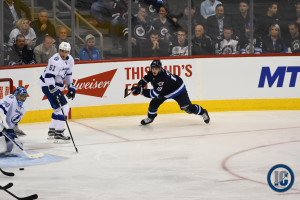When Claude Giroux came out of the Quebec Major Junior League in 2008, it was clear to all that he was a high-end talent. Not only was he coming off three straight 100-point seasons, and a strong showing with Canada’s gold medal winning World Junior Championship squad, but he utterly dominated the QMJHL playoffs, leading the league in scoring with 51 points in just 19 games. Based on that resume, it would have been incredibly easy for the Flyers to put the 20-year-old in the NHL in the fall of 2008, and yet, they resisted the urge – partly because Giroux was just 5’11, and around 170 lbs. Instead, they sent him to the AHL’s Philadelphia Phantoms, where Giroux spent just 33 games scoring 34 points.

Photo Credit: Colby Spence
Claude Giroux has since become one of the top forwards in the NHL, and he is one of the league’s leading scorers year after year. In fact, did you know that he’s the NHL’s top scorer since the fall of 2010? While it’s impossible to say what kind of player he would have become had he skipped the AHL, it’s certainly fair to say that spending half a season in the minors didn’t hurt his development.
Following a striking change in organizational philosophy, today’s Toronto Maple Leafs are doing things in a very similar way. Speaking about the organization’s “timeline” for player development, Assistant GM Kyle Dubas said the following:
“…we want the players to master the AHL level and the minor-league level and not bring them up after one good weekend,” he said. “They have to show us they can do all of the things. …Once our guys show they can master [the AHL] consistently, then we’ll have that conversation. That’s up to the players. Never been a hard and fast rule that no one is coming up this year.”
The key phrase there is “master the AHL”; while you could debate what “master” means, I interpret that to mean that a young player should stay in the minors until they prove that they’re too good for that level.
* * *
In an incredibly curious move from this off-season, the Winnipeg Jets opted not to re-sign veteran Lee Stempniak, despite the fact that Stempniak was keenly interested in staying. While it’s doubtful that anyone considered Stempniak to be part of the Jets’ core moving forward, he was a consistent 15-goal scorer with modest contract demands. In a worst-case scenario, he was good, affordable depth for the organization – a player who could play up and down the lineup, from (at least) the 2nd line, to the 4th line. And while passive observers have the benefit of hindsight, it’s worth noting that he has fit in incredibly well in New Jersey, scoring 12 points in 16 games, while making just $850,000 on a one-year contract. (That would put him third in scoring on the Jets, while putting him 12th in salary among forwards). Most importantly, the decision to let Stempniak go allowed Nic Petan – a 20-year-old rookie who is at most 5’9, 170 lbs. – to make the NHL without playing a single game with the Moose.

Photo Credit: Colby Spence
Let’s look at the possible reasons why the Jets held a spot open for a youngster, rather than re-signing Stempniak, or a similar player:
(1) Petan might be better
While you can’t analyze players in a vacuum, with 12 points in 16 games this season, and 10 points in 18 games last season with the Jets in a third line role, it’s hard to argue that Petan has made the Jets better than Stempniak would have, given that he has just 2 points through 14 games. Plus, if he was a key part of the team, he wouldn’t have been scratched 4 times this year.
(2) Petan would be cheaper
Petan will likely will be a bit cheaper than Stempniak this season, but not significantly. While Petan does have a lower base salary than Stempniak, if he were to hit all his bonuses (the clauses of which are unknown), his cap number will actually be slightly higher than Stempniak’s $850,000. Regardless, if Petan ends up making ~$100,000 less, that’s just .14% of the NHL’s $71.4M salary cap.
(3) The Jets already have plenty of organizational depth
Given the Moose’s struggles so far, this is a pretty easy one to address. The Moose currently sit second-last in the AHL, and they don’t have a single forward on the roster who is in the top-100 in league scoring. While that doesn’t mean that there aren’t some good players down there, it’s pretty clear that there’s no one currently banging down the door to get to the NHL.
(4) Petan will develop faster in the NHL than in the AHL
While there’s no iron-clad argument against this, a whole lot of anecdotal evidence would suggest that this isn’t the case. The “plug-and-play” approach – taking undeniably skilled, but very young players, and placing them directly in the NHL – failed miserably for years in places like Long Island in the late 90’s, Florida in the early 2000’s, Columbus in the mid-2000’s, and most recently, Edmonton. Meanwhile, the “draft and develop” model followed by teams like Tampa Bay, Nashville, and most famously, Detroit, has worked pretty nicely for several years now. Some of that is detailed here, and here.
If Petan were in the AHL, he’d be playing around 20 minutes per night, quarterbacking the powerplay, likely generating tons of scoring chances, and helping make his young teammates better. And if the Jets ran into injury troubles, or if he simply lit up the league – or “mastered the AHL” – they could call him up at any time. Instead, Petan is averaging 9:22 of ice-time per game, and playing primarily with Andrew Copp and Chris Thorburn – two gritty, hard-working players who don’t have a future as top-6 forwards. Not only is he not being put in a position to succeed – he’d be better complemented by a finisher with some size, like Drew Stafford – outside of the 1:23 per game he averages on the powerplay, he’s not really being given a chance at all.
Scale of the Problem
Taking a step back, is this situation the end of the world? Absolutely not. Nic Petan is a very skilled, intelligent player, and while his development might be better served in the AHL, he can still become a very productive player by following his current path, and a potential replacement for the style and offence of Mathieu Perreault (should he wish to depart when his contract expires at the end of 2017). But the logic behind this series of decisions is a concern, and for Jets fans, it’s something to keep an eye on.
If you like what you read, follow me on twitter @peteciamandias



